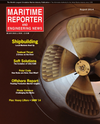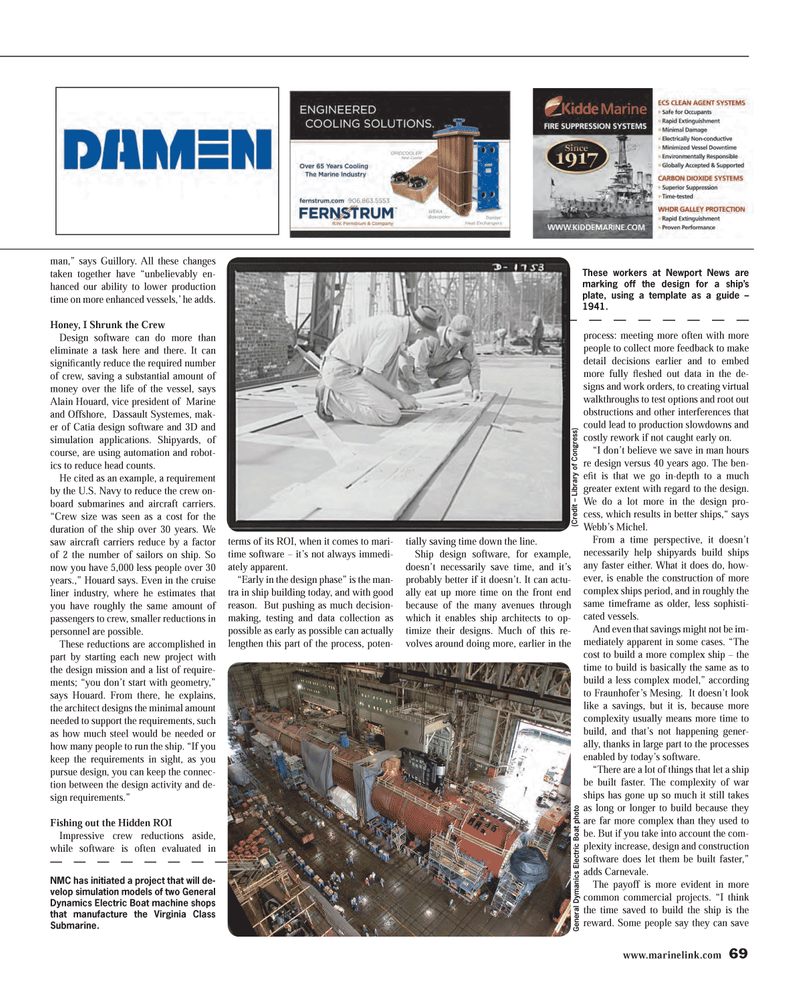
Page 69: of Maritime Reporter Magazine (August 2014)
Shipyard Edition
Read this page in Pdf, Flash or Html5 edition of August 2014 Maritime Reporter Magazine
www.marinelink.com 69man,? says Guillory. All these changes taken together have ?unbelievably en-hanced our ability to lower production time on more enhanced vessels,? he adds. Honey, I Shrunk the Crew Design software can do more than eliminate a task here and there. It can signiÞ cantly reduce the required number of crew, saving a substantial amount of money over the life of the vessel, says Alain Houard, vice president of Marine and Offshore, Dassault Systemes, mak- er of Catia design software and 3D and simulation applications. Shipyards, of course, are using automation and robot-ics to reduce head counts. He cited as an example, a requirement by the U.S. Navy to reduce the crew on-board submarines and aircraft carriers. ?Crew size was seen as a cost for the duration of the ship over 30 years. We saw aircraft carriers reduce by a factor of 2 the number of sailors on ship. So now you have 5,000 less people over 30 years.,? Houard says. Even in the cruise liner industry, where he estimates that you have roughly the same amount of passengers to crew, smaller reductions in personnel are possible. These reductions are accomplished in part by starting each new project with the design mission and a list of require-ments; ?you don?t start with geometry,? says Houard. From there, he explains, the architect designs the minimal amount needed to support the requirements, such as how much steel would be needed or how many people to run the ship. ?If you keep the requirements in sight, as you pursue design, you can keep the connec-tion between the design activity and de-sign requirements.? Fishing out the Hidden ROIImpressive crew reductions aside, while software is often evaluated in terms of its ROI, when it comes to mari-time software ? it?s not always immedi- ately apparent. ?Early in the design phase? is the man-tra in ship building today, and with good reason. But pushing as much decision-making, testing and data collection as possible as early as possible can actually lengthen this part of the process, poten-tially saving time down the line. Ship design software, for example, doesn?t necessarily save time, and it?s probably better if it doesn?t. It can actu- ally eat up more time on the front end because of the many avenues through which it enables ship architects to op-timize their designs. Much of this re-volves around doing more, earlier in the process: meeting more often with more people to collect more feedback to make detail decisions earlier and to embed more fully ß eshed out data in the de- signs and work orders, to creating virtual walkthroughs to test options and root out obstructions and other interferences that could lead to production slowdowns and costly rework if not caught early on. ?I don?t believe we save in man hours re design versus 40 years ago. The ben- eÞ t is that we go in-depth to a much greater extent with regard to the design. We do a lot more in the design pro- cess, which results in better ships,? says Webb?s Michel. From a time perspective, it doesn?t necessarily help shipyards build ships any faster either. What it does do, how- ever, is enable the construction of more complex ships period, and in roughly the same timeframe as older, less sophisti- cated vessels.And even that savings might not be im-mediately apparent in some cases. ?The cost to build a more complex ship ? the time to build is basically the same as to build a less complex model,? according to Fraunhofer?s Mesing. It doesn?t look like a savings, but it is, because more complexity usually means more time to build, and that?s not happening gener- ally, thanks in large part to the processes enabled by today?s software. ?There are a lot of things that let a ship be built faster. The complexity of war ships has gone up so much it still takes as long or longer to build because they are far more complex than they used to be. But if you take into account the com-plexity increase, design and construction software does let them be built faster,? adds Carnevale. The payoff is more evident in more common commercial projects. ?I think the time saved to build the ship is the reward. Some people say they can save These workers at Newport News are marking off the design for a ship?s plate, using a template as a guide ? 1941.(Credit ? Library of Congress) NMC has initiated a project that will de- velop simulation models of two General Dynamics Electric Boat machine shops that manufacture the Virginia Class Submarine. General Dymanics Electric Boat photoMR #8 (64-73).indd 69MR #8 (64-73).indd 698/7/2014 9:45:51 AM8/7/2014 9:45:51 AM

 68
68

 70
70
